|
|
| Разместил (Author): |
SergUA6  |
| Авторские права |
© http://www.radioscanner.ru |
|
|
Текст
|
SA OFDM module, constellations in channels.
Phase constellations in the channels of OFDM signals.
As usually, we will try to apply new options on the qualitative signal, with well-known parameters. In the first, it will allow us to estimate possibilities of the new method basically, and in the second, will give accurate enough representation of how to apply this method on real signals. For this purpose we have synthesized signal OFDM test2.wav.
Parameters of the test2.wav signal:
Number of channels - 30
Manipulation in the channels - pi/4 DQPSK
Step between channels (frequency net/grid)- 80 Hz
Manipulation speed - 66.6(6) Hz
Sampling rate of signals formation - 6400 Hz
Symbols length (LS) with CP, in samplings - 96
Length of defensive interval (LG), in samplings- 16
Symbols length (LU), block size IFFT/FFT, in samplings - 80
Preliminary, I wish to pay attention to one widespread enough mistake at the work with OFDM module. Very often in records of OFDM signals, there is a pause at the beginning. This pause it is not visible on a spectrum, because it is short enough and simply masks. Selecting a fragment of a signal for the analysis in OFDM module and capturing this pause, will strongly reduce efficiency of calculations, if the fragment is short enough. For example: we have 40 symbols for calculation of correlation triangle, while in reality we can have only 10 or less symbols, because the main body will get on absolutely not informative pause fragment. We do not speak about zero level, it can be pause in signal transmission, which somehow has gotten into record.
Example:
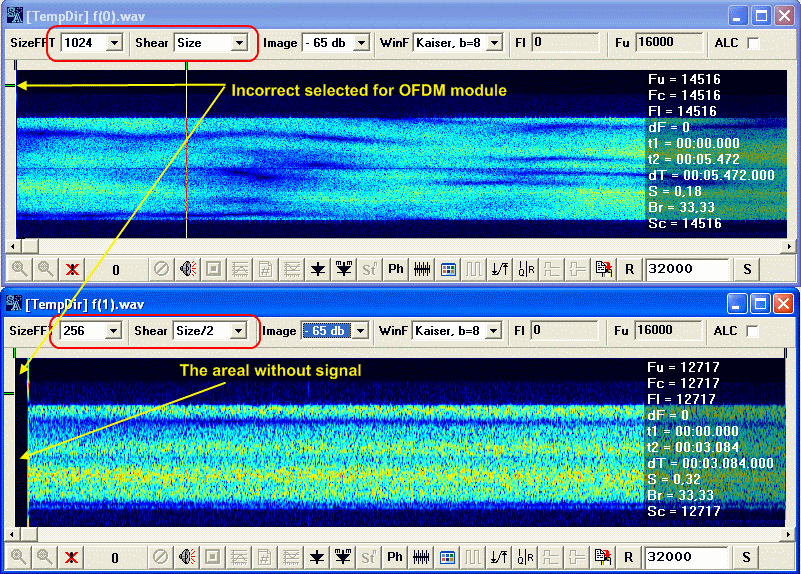
Such situations should be considered, it Is necessary be simply attentive. Especially it concerns to short signals. SA Free inserts a zero fragment into beginning of signals always, while SA Full in this respect, works more correctly.
Let's open in SA the test signal and select a fragment, please pay attention, we select the fragment from the beginning of the file, because we know that the signal is synthesized, and absolutely precisely does not contain any pauses. Now, let’s call OFDM module with default settings on, and start search for correlative triangle. There is no necessity to wait for the end of calculations, very often the triangle, which is not calling doubts, can be formed very fast, the program can be stopped at any moment. Although, in doubtful cases, it is better wait until the end of procedure.
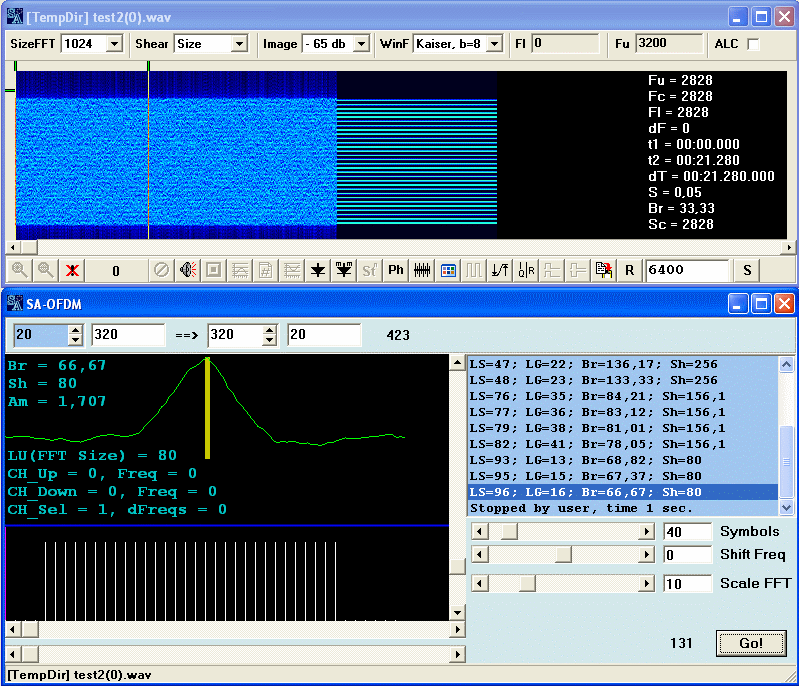
If everything has been done correctly, the triangle will be positioned with it's top precisely on the yellow marker automatically, because we are working right now with the ideal synthesized signal.
Let's select the first channel (the lower channel) by double click on the graphic. Now let's include constellation mapping also by double click on the necessary record in the list. Actions order does not play a special role. Further, it is possible to observe constellation in the lower channel moving on the signal symbol-by-symbol. Now it is visible, that in absolute angles it is PSK-8, in relative PSK-4, all is correct, it is classical pi/4 DQPSK.
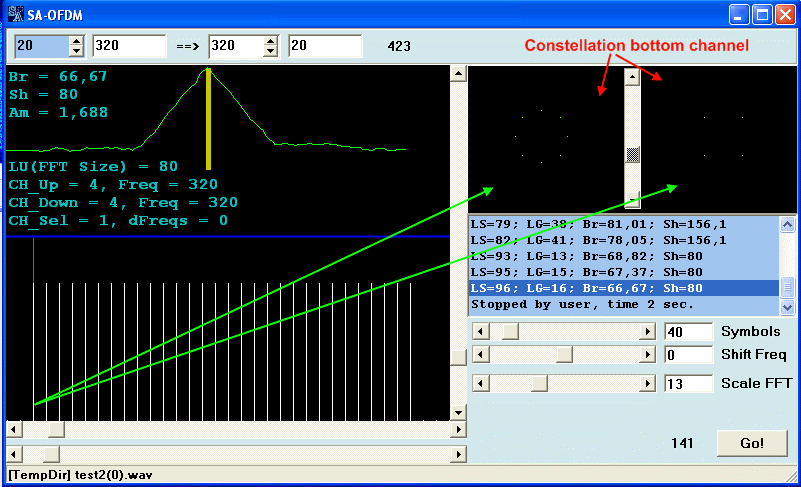
Selecting other channels on the graphic's spectrum by single click, and moving on the signal symbol-by-symbol, it is possible to receive constellation of any channel.
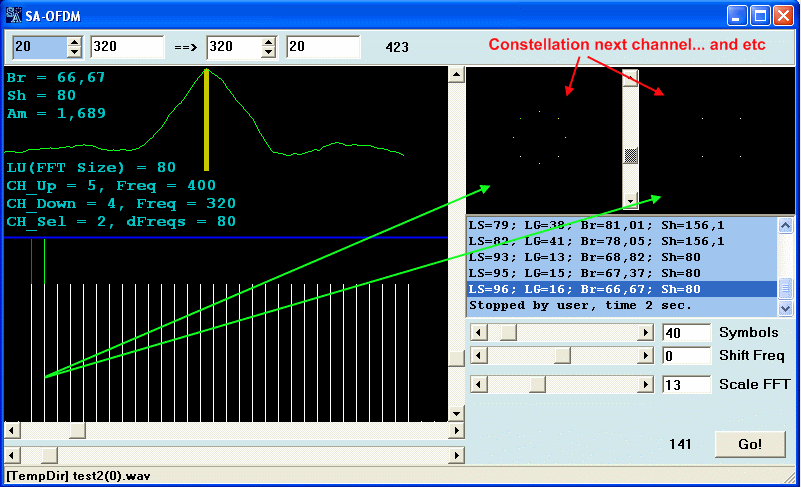
In the video clip - this procedure is shown visually. Sometimes it is much better to see something once, for better understanding.
While we were making this video clip there was small problem: As far as constellation's points, on an ideal signal are the real points in one pixel, they weren't visible in the video clip. Thus, it was necessary to change mapping algorithm. Thereupon, for everyone who has version 6.1.0.5, it is necessary to update it to version 6.1.0.5a.
There is some thin moment, both absolute, and the relative constellations will be always precisely oriented on axes on any channel. Stable orientation of constellations, is a result of ideality of conditions of analyzed signal. These conditions are unstable, it is enough to shift the marker from triangle's top on the left slope, and from exact orientation on axes for absolute angles remains nothing. While for relative constellation everything stays former.
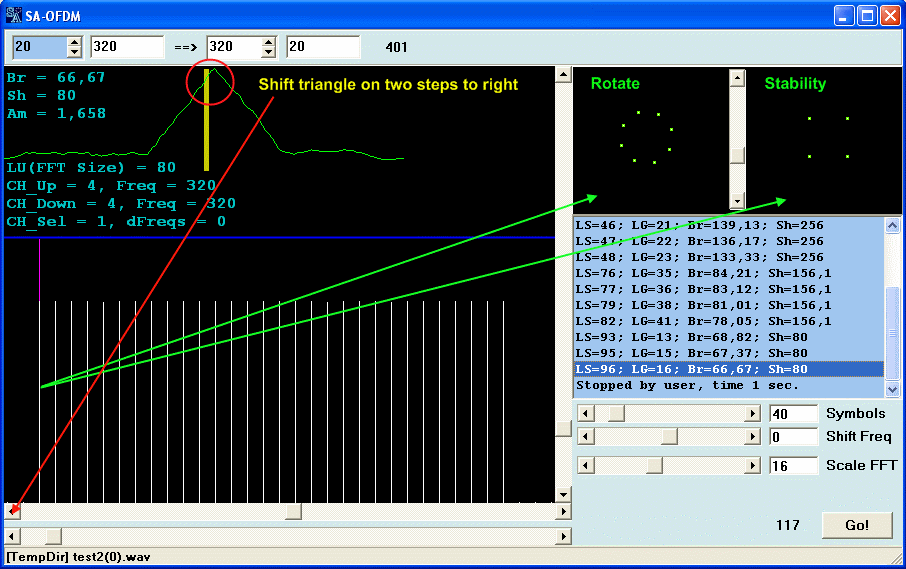
Why it occurs? Shift on the good side of triangle, as you should remember from the previous articles, guarantees a choice of one of correct LU. The quantity of LU in OFDM signal with CP is equal to LG+1. Remember the picture:
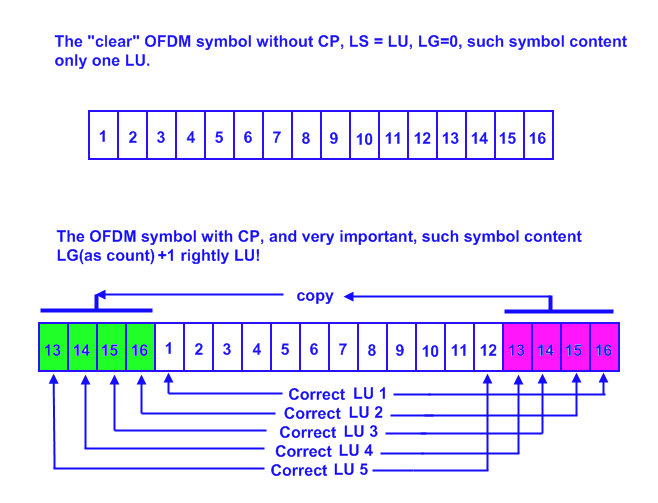
All LU differ from each other by phase shifts. Initially, while the marker was precisely at top of triangle, the latest LU was processed, and as this LU is "parent" of all other LU on it, at observance of all conditions, it is possible to demodulate the symbol and the whole signal. Actually this LU is the purpose of demodulator, because other LU mostly are spent on distortions in the signal. That is why, as soon as we go away from the "true LU", we receive casual phase shift in absolute angles, while it is not reflected anyhow on relative angles.
To complete the picture, it is necessary to consider one more moment. We loaded the signal's fragment precisely from the first symbol, from beginning of the file. What if we will load file from random fragment? In this case, everything remains same: absolute angles will be randomly shifted, even if the yellow marker will stand precisely at triangle top. Relative remain stable.
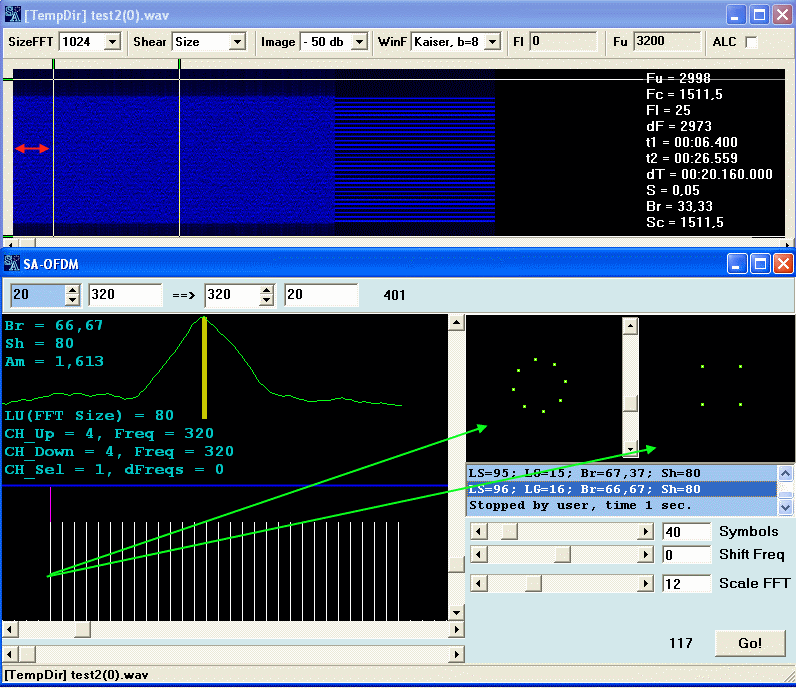
What has happened? Isn't LU now "not native", after all, it is last LU in the complete symbol? LU is still "native", but if to speak more correctly, LU is the most authentic from all others, because distortions will reach it in the last moment. But now we got "not native" symbol!:) The program considers it as first symbol, while in practice we do not really know it. Yes, yes, in OFDM everything is so coordinated: symbol number, and number of LU, both sampling rate, and shift on frequency all that is coordinated. If one of these parameters is not that one, which should be, then chaos begins in absolute angles:)
Fortunately we have strong enough order in relative angles. Although, it is also not very stable. For this reason, relative sorts of manipulations are so widespread in OFDM.
In reality, all is not so terrible as it is represented, the matter is that even not native symbol, and not native LU, at exact observance of all other parameters(such as the sampling rate and shift on frequency) do not threaten with anything deadly, except, a turn of absolute constellation relatively axes, of what we were convinced just now. The constellation is drawn correctly, and to calculate the angle of an error and to compensate it for each channel is possible. It is not an easy task, but this task has decisions.
In practice, any not distorted LU suits for the analysis, basically it is not important which number has the symbol. The maximum that it is possible to lose, in this case, is the correct orientation of absolute constellation. This loss is not too great for the analyzer.
Let's look, what results will bring not precise sampling rate. As minimum - the triangle will slide concerning to marker in this or that side, that automatically means that at symbol-by-symbol moving, there is almost no chance to stay on same LU. It pulls behind itself complete chaos in absolute angles, in this case, we cannot speak about any stable constellation. Also depending on speed of moving of the triangle, there can be order distortions in relative angles. There also can be different problems at the channel changing.
Let's check it up. We will change sampling rate on 1 Hz.
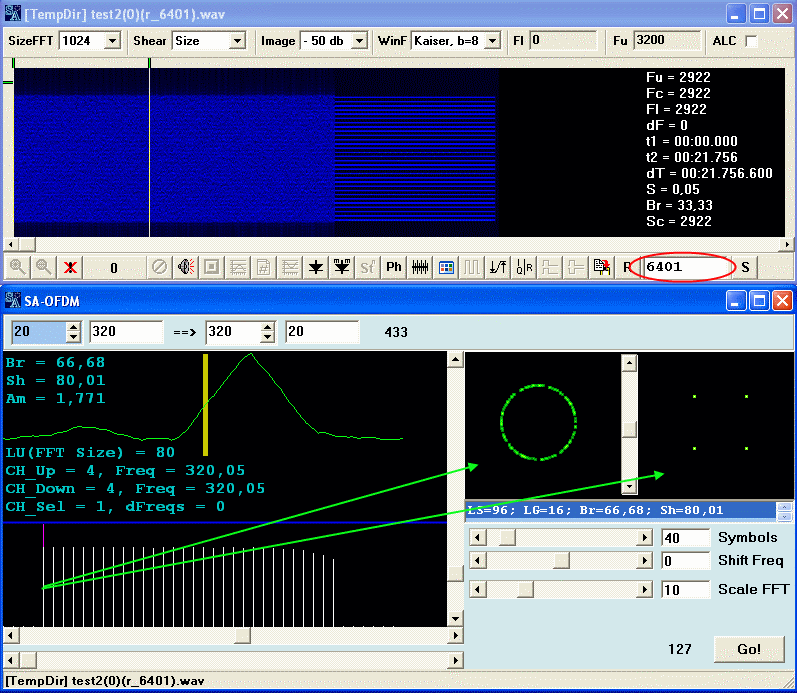
As it was anticipated, there is complete chaos in absolute angles. The constellation is not simply developed, it permanently turns around. In relative angles we have something looks like an order, but, at the big errors there also will be problems, with one difference from absolute angles, the constellation will not turn around constantly. At more serious changing of sampling rate, we observe more bright problems.
Let's watch what will give shift by on frequency in 0.1 Hz.

Everything will be same, but sensitivity to shift will become stronger, then to changing of sampling rate.
We will not bring examples, what will happen at shift of the signal by frequency and not correct sampling rate at same time, it is obvious that very serious problems will appear. The purpose of all this - is to show level of sensitivity of OFDM signals to these parameters.
And here it is best time to remember, in what conditions, we are situated, when we have got record of really unknown OFDM signal. Generally, we do not know anything:
1) neither the sampling rate of creation of the signal
2) nor sampling rate of the record
3) we also don't know exact frequency of signal and etc.
As we saw signal's shift only in 0.1 Hz, practically disorganizes an absolute constellation. It means, that without auto regulation systems, chances to get exact parameters of modulation are extremely not great. But there is one more problem that is : to make the self tuning system work, it is necessary to know what exact values it is necessary to support. As far as it is impossible to receive exact parameters, as in general nothing is known exactly.:) The vicious circle. This is the main complexity of OFDM analysis, in difference from demodulation, when we have the signal with completely known parameters.
Really everything is so bad? To tell the truth, all is not too good, and at this moment all we have - is the possibility to observe convincingly enough, only relative constellations, what it gives? Unfortunately nothing very great. Even having good relative constellation, without accurate absolute constellation, it is not possible to guarantee neither a modulation mode in the channel, nor value of clock frequency, neither accuracy of position of a signal on frequency, nor an exact rating of a grid of channels. All it will be: something, somewhere, in a range of something.
Why the relative constellation, does not allow to define manipulation parameters precisely? The matter is that, for example, within the limits of relative manipulation pi/4 DQPSK, it is possible, and very often it used to be done, that both PSK-2 and PSK-4 are used. And there are two variants of PSK-2, with different orientation concerning axes. Nothing prevents to use relative manipulation 3*pi/8 DPSK-8, and it is used often. This sort of relative manipulation, has in it's arsenal, even more variants and types. Generally, there is no possibility to tell precisely, only by the look of relative constellation, if it is really relative manipulation or absolute is used.
Random phase shifts in the channels are not limited, and they very easily can create illusion of obvious and very strong constellation in absolute angles.
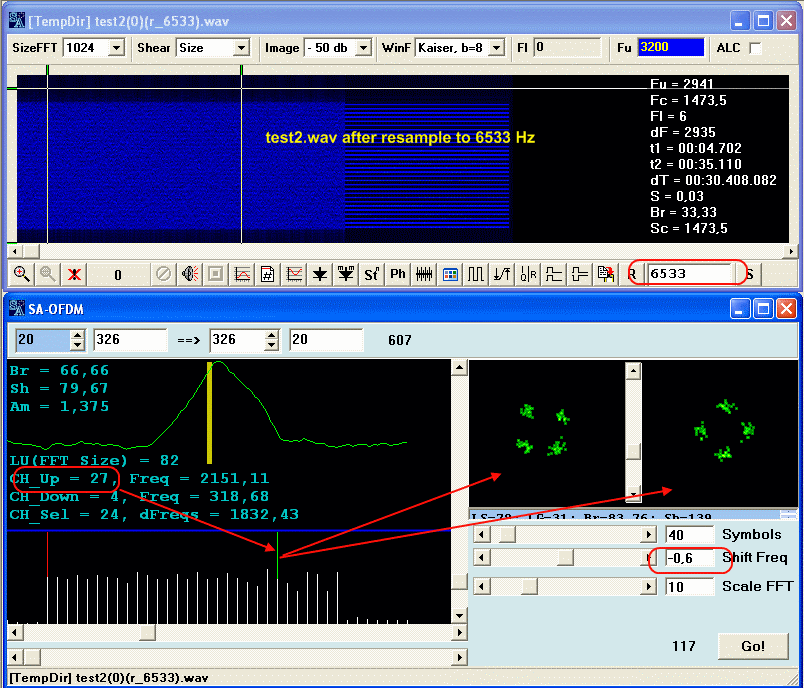
Is it possible to prove that in this channel is not absolute PSK-4 or QPSK, and all the same pi/4 DQPSK, while the triangle is not sliding at symbol-by-symbol moving, its peak positive and LU size is even? But it is possible to make convincing absolute constellation almost in any channel.
Basically, it is possible to guarantee something only on ideal, or qualitative records yet. Thus, it is necessary concern results, received in the current version of OFDM module carefully enough.
The problem is very hard and interesting; we are planning to go further with our developments in this direction.
Good Luck~
|
|
|
|
Добавлять комментарии могут только зарегистрированные, активировавшие регистрацию и не ограниченные в доступе участники сайта!
|
| Файл создан: 13 Dec 2009 18:05, посл. исправление: 13 Dec 2009 20:02 |
|

